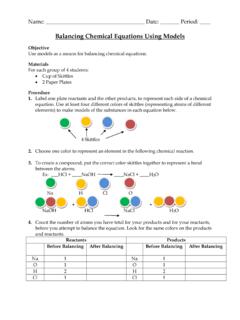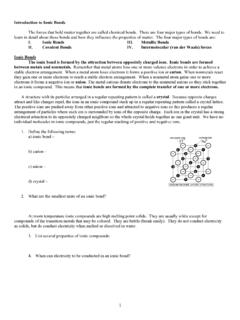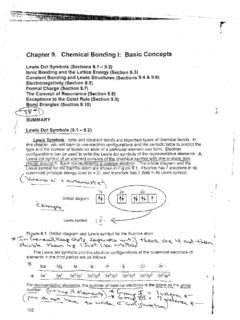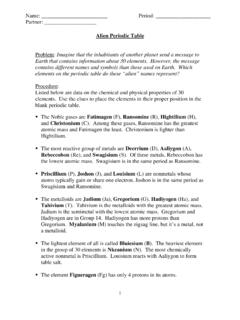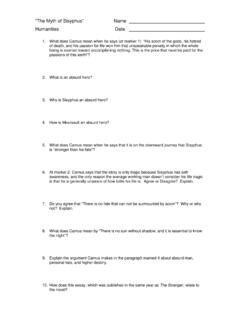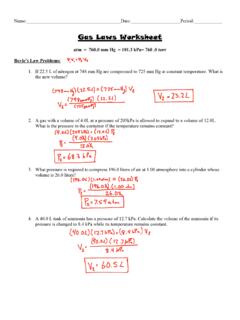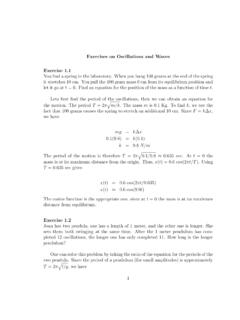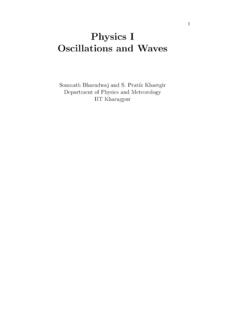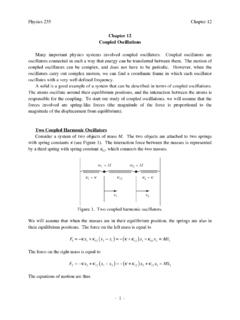Transcription of Chapter8 Oscillations - New Providence School District
1 Chapter 8. Oscillations 286. 287. AP Physics Multiple Choice Practice Oscillations 1. A mass m, attached to a horizontal massless spring with spring constant k, is set into simple harmonic motion. Its maximum displacement from its equilibrium position is A. What is the mass's speed as it passes through its equilibrium position? k m 1 k 1 m (A) A (B) A (C) (D). m k A m A k 2. A mass m is attached to a spring with a spring constant k. If the mass is set into simple harmonic motion by a displacement d from its equilibrium position, what would be the speed, v, of the mass when it returns to the equilibrium position? md kd kd k (A) v (B) v (C) v (D) v d k m mg m 3. Which of the following is true for a system consisting of a mass oscillating on the end of an ideal spring? (A) The kinetic and potential energies are equal to each other at all times. (B) The kinetic and potential energies are both constant. (C) The maximum potential energy is achieved when the mass passes through its equilibrium position.
2 (D) The maximum kinetic energy and maximum potential energy are equal, but occur at different times. Questions 4-5: A block oscillates without friction on the end of a spring as shown. The minimum and maximum lengths of the spring as it oscillates are, respectively, xmin and xmax. The graphs below can represent quantities associated with the oscillation as functions of the length x of the spring. (A) (B) (C) (D). 4. Which graph can represent the total mechanical energy of the block-spring system as a function of x ? (A) A (B) B (C) C (D) D. 5. Which graph can represent the kinetic energy of the block as a function of x ? (A) A (B) B (C) C (D) D. 6. An object swings on the end of a cord as a simple pendulum with period T. Another object oscillates up and down on the end of a vertical spring also with period T. If the masses of both objects are doubled, what are the new values for the Periods? Pendulum Mass on Spring (A) T T 2.
3 2. (B) T T 2. (C) T 2 T. (D) T 2 T. 2. 288. 7. An object is attached to a spring and oscillates with amplitude A. and period T, as represented on the graph. The nature of the velocity v and acceleration a of the object at time T/4 is best represented by which of the following? (A) v > 0, a > 0 (B) v > 0, a < 0. (C) v > 0, a = 0 (D) v = 0, a < 0. 8. When an object oscillating in simple harmonic motion is at its maximum displacement from the equilibrium position. Which of the following is true of the values of its speed and the magnitude of the restoring force? Speed Restoring Force (A) Zero Maximum (B) Zero Zero (C) Maximum maximum (D) Maximum Zero 9. A particle oscillates up and down in simple harmonic motion. Its height y as a function of time t is shown in the diagram. At what time t does the particle achieve its maximum positive acceleration? (A) 1 s (B) 2 s (C) 3 s (D) 4 s 10. The graph shown represents the potential energy U as a function of displacement x for an object on the end of a spring moving back and forth with amplitude x.
4 Which of the following graphs represents the kinetic energy K of the object as a function of displacement x ? 289. Questions 11-12. A sphere of mass m1, which is attached to a spring, is displaced downward from its equilibrium position as shown above left and released from rest. A sphere of mass m2, which is suspended from a string of length L, is displaced to the right as shown above right and released from rest so that it swings as a simple pendulum with small amplitude. Assume that both spheres undergo simple harmonic motion 11. Which of the following is true for both spheres? (A) The maximum kinetic energy is attained as the sphere passes through its equilibrium position (B) The maximum kinetic energy is attained as the sphere reaches its point of release. (C) The minimum gravitational potential energy is attained as the sphere passes through its equilibrium position. (D) The maximum gravitational potential energy is attained when the sphere reaches its point of release.
5 (E) The maximum total energy is attained only as the sphere passes through its equilibrium position. 12. If both spheres have the same period of oscillation, which of the following is an expression for the spring constant (A) L / m1g (B) g / m2L. (C) m2g / L. (D) m1g / L. 13. A simple pendulum and a mass hanging on a spring both have a period of 1 s when set into small oscillatory motion on Earth. They are taken to Planet X, which has the same diameter as Earth but twice the mass. Which of the following statements is true about the periods of the two objects on Planet X compared to their periods on Earth? (A) Both are shorter. (B) Both are the same. (C) The period of the mass on the spring is shorter; that of the pendulum is the same. (D) The period of the pendulum is shorter; that of the mass on the spring is the same Questions 14-15. A -kilogram block is attached to an initially unstretched spring of force constant k = 40 newtons per meter as shown above.
6 The block is released from rest at time t = 0. 14. What is the amplitude, in meters, of the resulting simple harmonic motion of the block? 1 1 1 1. (A) m (B) m (C) m (D) m 40 20 4 2. 290. 15. What will the resulting period of oscillation be? . s s s s (A) 40 (B) 20 (C) 10 (D) 4. 16. A ball is dropped from a height of 10 meters onto a hard surface so that the collision at the surface may be assumed elastic. Under such conditions the motion of the ball is (A) simple harmonic with a period of about s (B) simple harmonic with a period of about s (C) simple harmonic with an amplitude of 5 m (D) periodic with a period of about s but not simple harmonic Questions 17-18 refer to the graph below of the displacement x versus time t for a particle in simple harmonic motion. 17. Which of the following graphs shows the kinetic energy K of the particle as a function of time t for one cycle of motion? 18. Which of the following graphs shows the kinetic energy K of the particle as a function of its displacement x ?
7 19. A mass m is attached to a vertical spring stretching it distance d. Then, the mass is set oscillating on a spring with an amplitude of A, the period of oscillation is proportional to d g d m2 g (A) (B) (C) (D). g d mg d 20. Two objects of equal mass hang from independent springs of unequal spring constant and oscillate up and down. The spring of greater spring constant must have the (A) smaller amplitude of oscillation (B) larger amplitude of oscillation (C) shorter period of oscillation (D) longer period of oscillation 291. Questions 21-22. A block on a horizontal frictionless plane is attached to a spring, as shown above. The block oscillates along the x-axis with simple harmonic motion of amplitude A. 21. Which of the following statements about the block is correct? (A) At x = 0, its acceleration is at a maximum. (B) At x = A, its displacement is at a maximum. (C) At x = A, its velocity is at a maximum. (D) At x = A, its acceleration is zero.
8 22. Which of the following statements about energy is correct? (A) The potential energy of the spring is at a minimum at x = 0. (B) The potential energy of the spring is at a minimum at x = A. (C) The kinetic energy of the block is at a minimum at x =0. (D) The kinetic energy of the block is at a maximum at x = A. 23. A simple pendulum consists of a kilogram brass bob on a string about meter long. It has a period of seconds. The pendulum would have a period of second if the (A) string were replaced by one about meter long (B) string were replaced by one about meters long (C) bob were replaced by a kg brass sphere (D) bob were replaced by a kg brass sphere 24. A pendulum with a period of 1 s on Earth, where the acceleration due to gravity is g, is taken to another planet, where its period is 2 s. The acceleration due to gravity on the other planet is most nearly (A) g/4 (B) g/2 (C) 2g (D) 4g 25. An ideal massless spring is fixed to the wall at one end, as shown above.
9 A block of mass M attached to the other end of the spring oscillates with amplitude A on a frictionless, horizontal surface. The maximum speed of the block is vm. The force constant of the spring is Mg Mgvm Mv m2 Mv m2. (A) (B) (C) (D). A 2A 2A A2. 292. AP Physics Free Response Practice Oscillations 1975B7. A pendulum consists of a small object of mass m fastened to the end of an inextensible cord of length L. Initially, the pendulum is drawn aside through an angle of 60 with the vertical and held by a horizontal string as shown in the diagram above. This string is burned so that the pendulum is released to swing to and fro. a. In the space below draw a force diagram identifying all of the forces acting on the object while it is held by the string. b. Determine the tension in the cord before the string is burned. c. Show that the cord, strong enough to support the object before the string is burned, is also strong enough to support the object as it passes through the bottom of its swing.
10 D. The motion of the pendulum after the string is burned is periodic. Is it also simple harmonic? Why, or why not? 1983B2. A block of mass M is resting on a horizontal, frictionless table and is attached as shown above to a relaxed spring of spring constant k. A second block of mass 2M and initial speed v o collides with and sticks to the first block Develop expressions for the following quantities in terms of M, k, and v o a. v, the speed of the blocks immediately after impact b. x, the maximum distance the spring is compressed c. T, the period of the subsequent simple harmonic motion 293. 1995B1. As shown above, a mass is sliding on a horizontal, frictionless air track with a speed of meters per second when it instantaneously hits and sticks to a mass initially at rest on the track. The mass is connected to one end of a massless spring, which has a spring constant of 100 newtons per meter. The other end of the spring is fixed.

